Parliamentary Submission: Housing for Indigenous Australians
VerifiedAdded on 2023/01/19
|14
|3092
|97
Report
AI Summary
This report addresses the critical issue of housing for Indigenous Australians, focusing on its profound impact on health outcomes. It begins by establishing the background, emphasizing the detrimental effects of poor housing conditions on physical and mental health, particularly within the Aboriginal community. The methodology involves a comprehensive review of health reports, surveys, and data analysis of housing tenure types and conditions. The results highlight significant disparities in housing quality, affordability, and living conditions among different tenure groups, revealing that social housing residents often face the poorest conditions. The discussion section underscores the link between these housing challenges and social determinants of health, such as socioeconomic status, access to resources, and social support. The report concludes with recommendations for policy changes aimed at improving housing conditions, increasing affordability, and promoting healthier living environments for Indigenous Australians. The report emphasizes the need for government and community support to address the housing crisis and its health consequences.
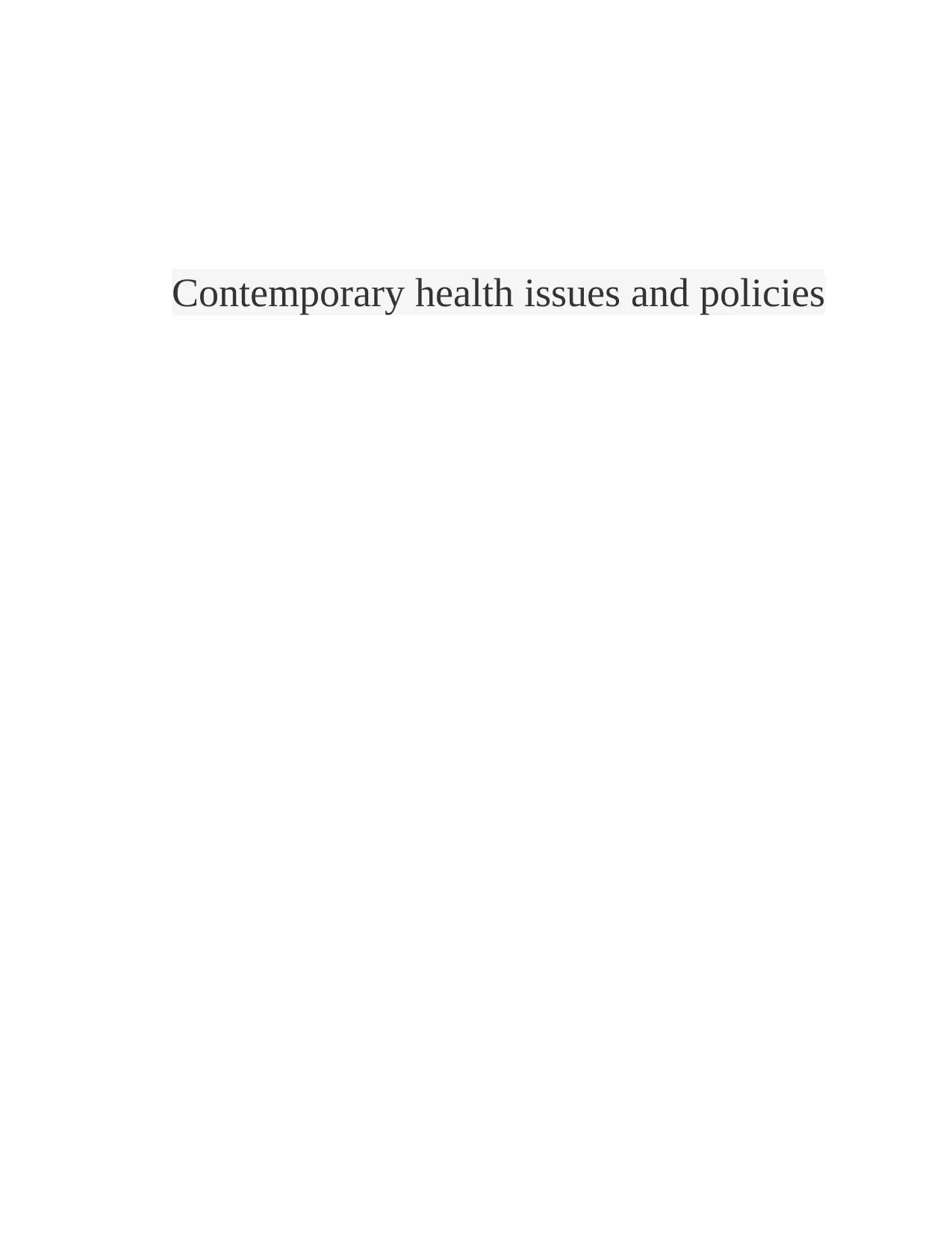
Contemporary health issues and policies
Paraphrase This Document
Need a fresh take? Get an instant paraphrase of this document with our AI Paraphraser

TABLE OF CONTENTS
S.NO. TOPIC PAGE NO.
1 Background 3
2 Methods 4
3 Results 7
4 Discussions 10
5 Conclusion of the report 12
6 References 13
S.NO. TOPIC PAGE NO.
1 Background 3
2 Methods 4
3 Results 7
4 Discussions 10
5 Conclusion of the report 12
6 References 13

1. BACKGROUND
There is availability of large number of researches and evidences which shows that, without any
doubt, the housing facilities and environment affects the people living in that area in varieties of
ways. Primary affects of it are on the heath condition, their working capabilities & productivity
and wellbeing. When people live in poor housing condition, it may affect the individual in
varieties of ways like, poor housing condition will promote the diseases in the people, and it
increases crowding, poor focus on the children’s behavior and progress in schools, pulmonary
illness, higher risks of infectious diseases and mental illness (Priest, Paradies, Stevens & Bailie,
2012). By this, we can say that, poor housing facilities or conditions can affect the individual in
both direct and indirect ways.
When talking about the Aboriginals of Australia, they had already faced great consequences due
to social discriminations. Due to this, they fell backwards socially and economically. They
experiences disadvantages which includes the poor health conditions, poverty, unemployment,
illiteracy, imprisonment and housing (Grant, 2013). Improper or poor housing facility was
considered to be the main reason behind the poor health condition of the Torres Strait Islander
Australians and Aboriginals. Evidences which supports the relation between the poor housing
facilities and the higher probabilities of getting ill can also be gathered from the other countries
like Canada, New Zealand and USA (Fien & Charlesworth, 2012). When talking about the
indigenous of Australia, there is still a great population of them who are witnessing poor housing
which resulting into overcrowding and the problems of no home. They are also unable to
complete the basic health requirements like proper flushing toilets, facilities of bathing, washing
clothes or to cook food in a hygienic condition. All these facilities are found to be missing in
these houses.
There is availability of large number of researches and evidences which shows that, without any
doubt, the housing facilities and environment affects the people living in that area in varieties of
ways. Primary affects of it are on the heath condition, their working capabilities & productivity
and wellbeing. When people live in poor housing condition, it may affect the individual in
varieties of ways like, poor housing condition will promote the diseases in the people, and it
increases crowding, poor focus on the children’s behavior and progress in schools, pulmonary
illness, higher risks of infectious diseases and mental illness (Priest, Paradies, Stevens & Bailie,
2012). By this, we can say that, poor housing facilities or conditions can affect the individual in
both direct and indirect ways.
When talking about the Aboriginals of Australia, they had already faced great consequences due
to social discriminations. Due to this, they fell backwards socially and economically. They
experiences disadvantages which includes the poor health conditions, poverty, unemployment,
illiteracy, imprisonment and housing (Grant, 2013). Improper or poor housing facility was
considered to be the main reason behind the poor health condition of the Torres Strait Islander
Australians and Aboriginals. Evidences which supports the relation between the poor housing
facilities and the higher probabilities of getting ill can also be gathered from the other countries
like Canada, New Zealand and USA (Fien & Charlesworth, 2012). When talking about the
indigenous of Australia, there is still a great population of them who are witnessing poor housing
which resulting into overcrowding and the problems of no home. They are also unable to
complete the basic health requirements like proper flushing toilets, facilities of bathing, washing
clothes or to cook food in a hygienic condition. All these facilities are found to be missing in
these houses.
⊘ This is a preview!⊘
Do you want full access?
Subscribe today to unlock all pages.

Trusted by 1+ million students worldwide

2. METHODS
2.1. Sampling strategy
In this, all the reports of the health conditions of the indigenous children were compiled.
Diseases from which the children of the indigenous community were suffering were also
recorded. The Search result of the ACCHS and NSW were studied.
For this purpose, the Aboriginal children were diagnosed for their health conditions to gather the
data. The data of the past 20 years related to the funding programs were studied. All the
participants were then surveyed for their housing facilities.
2.2. Measures
The team responsible for the survey work completed the survey about the indigenous children’s
physical and mental health. The survey also included the findings about the lifestyle and
demographic views of them including the housing. A totally new questionnaire was also
developed for them for knowing about their housing facilities.
2.3. Tenure type
The people who participated in the survey were then categorized into three categories. First
category included all those people who were having their own house. Second category people
were living in the houses for which they are paying rents. Third category people were living in
the houses which were provided by the social service NGOs or through government policies
(Petersen, Parsell, Phillips & White, 2014).
2.4. Other housing variables
A questionnaire was prepared by the team which was having questions about the housing
facilities and living conditions of the aboriginal people. It was found that, there were certain
2.1. Sampling strategy
In this, all the reports of the health conditions of the indigenous children were compiled.
Diseases from which the children of the indigenous community were suffering were also
recorded. The Search result of the ACCHS and NSW were studied.
For this purpose, the Aboriginal children were diagnosed for their health conditions to gather the
data. The data of the past 20 years related to the funding programs were studied. All the
participants were then surveyed for their housing facilities.
2.2. Measures
The team responsible for the survey work completed the survey about the indigenous children’s
physical and mental health. The survey also included the findings about the lifestyle and
demographic views of them including the housing. A totally new questionnaire was also
developed for them for knowing about their housing facilities.
2.3. Tenure type
The people who participated in the survey were then categorized into three categories. First
category included all those people who were having their own house. Second category people
were living in the houses for which they are paying rents. Third category people were living in
the houses which were provided by the social service NGOs or through government policies
(Petersen, Parsell, Phillips & White, 2014).
2.4. Other housing variables
A questionnaire was prepared by the team which was having questions about the housing
facilities and living conditions of the aboriginal people. It was found that, there were certain
Paraphrase This Document
Need a fresh take? Get an instant paraphrase of this document with our AI Paraphraser
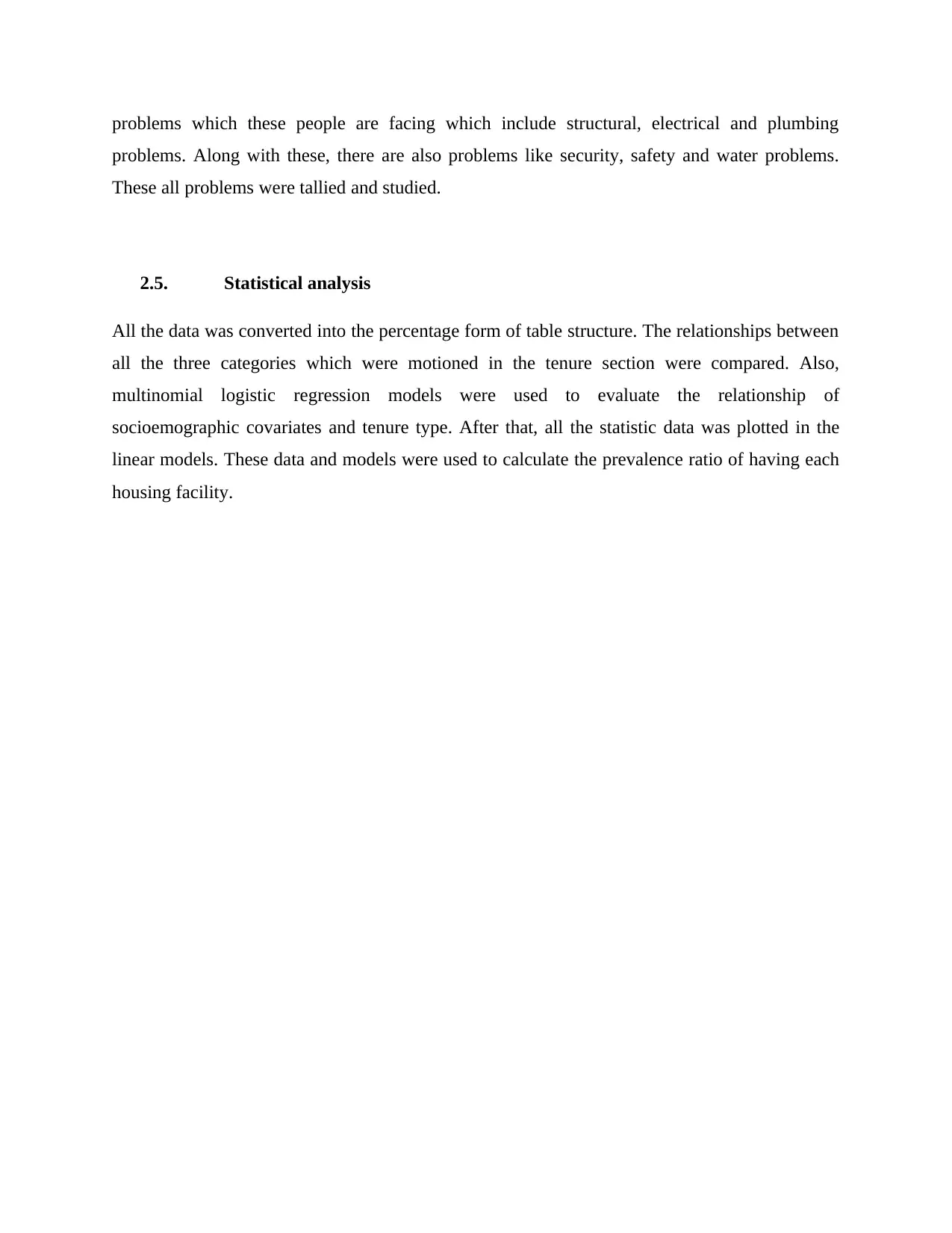
problems which these people are facing which include structural, electrical and plumbing
problems. Along with these, there are also problems like security, safety and water problems.
These all problems were tallied and studied.
2.5. Statistical analysis
All the data was converted into the percentage form of table structure. The relationships between
all the three categories which were motioned in the tenure section were compared. Also,
multinomial logistic regression models were used to evaluate the relationship of
socioemographic covariates and tenure type. After that, all the statistic data was plotted in the
linear models. These data and models were used to calculate the prevalence ratio of having each
housing facility.
problems. Along with these, there are also problems like security, safety and water problems.
These all problems were tallied and studied.
2.5. Statistical analysis
All the data was converted into the percentage form of table structure. The relationships between
all the three categories which were motioned in the tenure section were compared. Also,
multinomial logistic regression models were used to evaluate the relationship of
socioemographic covariates and tenure type. After that, all the statistic data was plotted in the
linear models. These data and models were used to calculate the prevalence ratio of having each
housing facility.
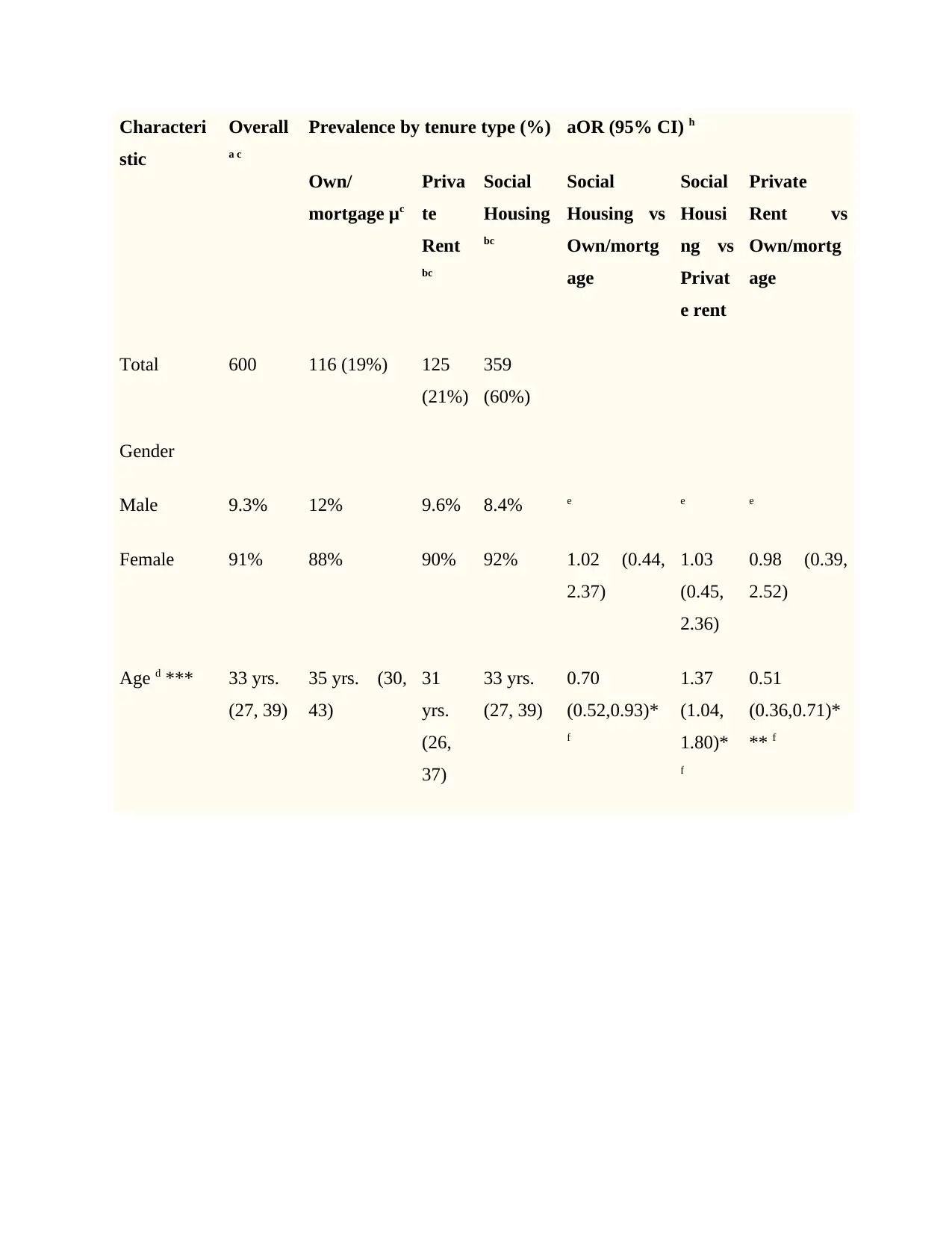
Characteri
stic
Overall
a c
Prevalence by tenure type (%) aOR (95% CI) h
Own/
mortgage μc
Priva
te
Rent
bc
Social
Housing
bc
Social
Housing vs
Own/mortg
age
Social
Housi
ng vs
Privat
e rent
Private
Rent vs
Own/mortg
age
Total 600 116 (19%) 125
(21%)
359
(60%)
Gender
Male 9.3% 12% 9.6% 8.4% e e e
Female 91% 88% 90% 92% 1.02 (0.44,
2.37)
1.03
(0.45,
2.36)
0.98 (0.39,
2.52)
Age d *** 33 yrs.
(27, 39)
35 yrs. (30,
43)
31
yrs.
(26,
37)
33 yrs.
(27, 39)
0.70
(0.52,0.93)*
f
1.37
(1.04,
1.80)*
f
0.51
(0.36,0.71)*
** f
stic
Overall
a c
Prevalence by tenure type (%) aOR (95% CI) h
Own/
mortgage μc
Priva
te
Rent
bc
Social
Housing
bc
Social
Housing vs
Own/mortg
age
Social
Housi
ng vs
Privat
e rent
Private
Rent vs
Own/mortg
age
Total 600 116 (19%) 125
(21%)
359
(60%)
Gender
Male 9.3% 12% 9.6% 8.4% e e e
Female 91% 88% 90% 92% 1.02 (0.44,
2.37)
1.03
(0.45,
2.36)
0.98 (0.39,
2.52)
Age d *** 33 yrs.
(27, 39)
35 yrs. (30,
43)
31
yrs.
(26,
37)
33 yrs.
(27, 39)
0.70
(0.52,0.93)*
f
1.37
(1.04,
1.80)*
f
0.51
(0.36,0.71)*
** f
⊘ This is a preview!⊘
Do you want full access?
Subscribe today to unlock all pages.

Trusted by 1+ million students worldwide
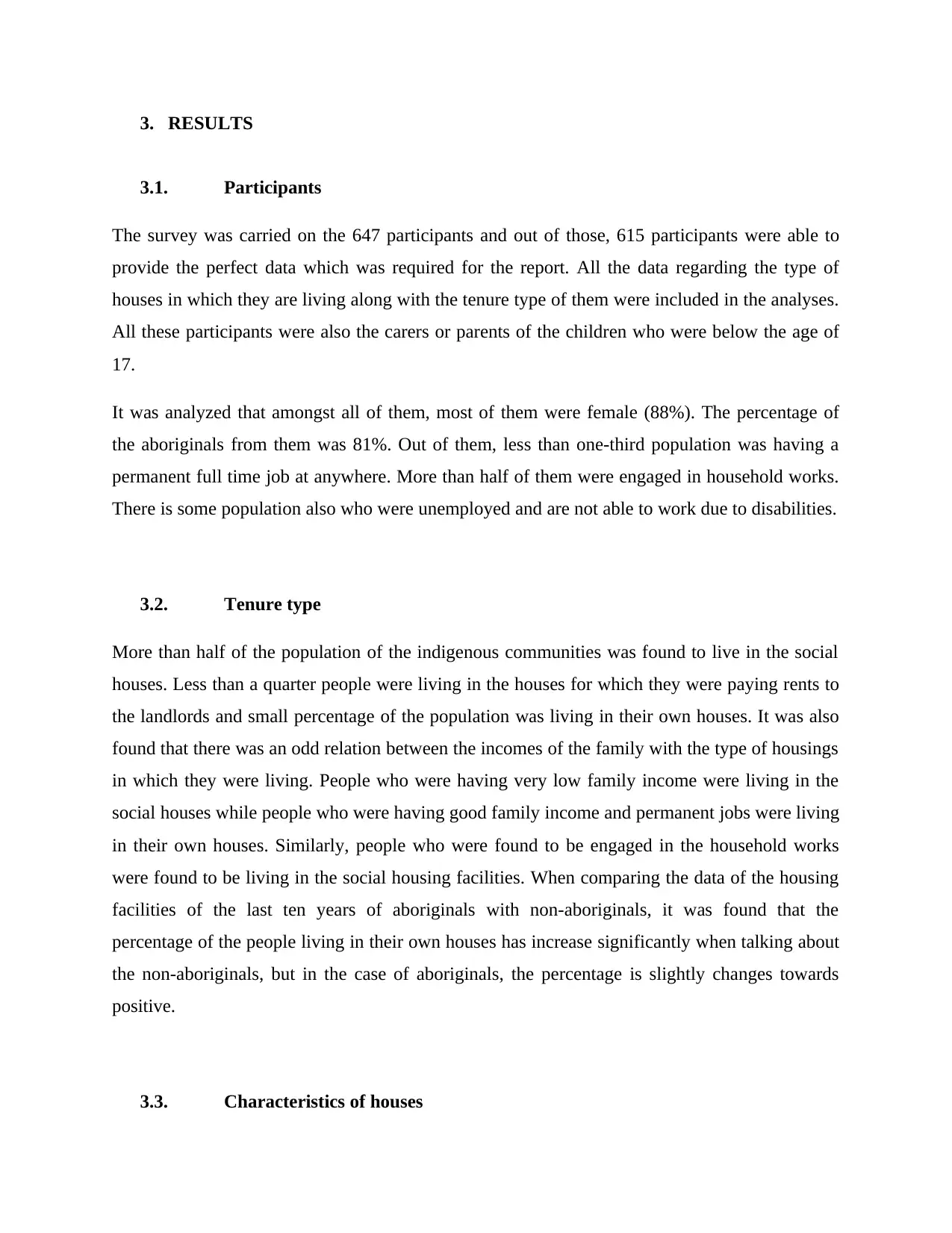
3. RESULTS
3.1. Participants
The survey was carried on the 647 participants and out of those, 615 participants were able to
provide the perfect data which was required for the report. All the data regarding the type of
houses in which they are living along with the tenure type of them were included in the analyses.
All these participants were also the carers or parents of the children who were below the age of
17.
It was analyzed that amongst all of them, most of them were female (88%). The percentage of
the aboriginals from them was 81%. Out of them, less than one-third population was having a
permanent full time job at anywhere. More than half of them were engaged in household works.
There is some population also who were unemployed and are not able to work due to disabilities.
3.2. Tenure type
More than half of the population of the indigenous communities was found to live in the social
houses. Less than a quarter people were living in the houses for which they were paying rents to
the landlords and small percentage of the population was living in their own houses. It was also
found that there was an odd relation between the incomes of the family with the type of housings
in which they were living. People who were having very low family income were living in the
social houses while people who were having good family income and permanent jobs were living
in their own houses. Similarly, people who were found to be engaged in the household works
were found to be living in the social housing facilities. When comparing the data of the housing
facilities of the last ten years of aboriginals with non-aboriginals, it was found that the
percentage of the people living in their own houses has increase significantly when talking about
the non-aboriginals, but in the case of aboriginals, the percentage is slightly changes towards
positive.
3.3. Characteristics of houses
3.1. Participants
The survey was carried on the 647 participants and out of those, 615 participants were able to
provide the perfect data which was required for the report. All the data regarding the type of
houses in which they are living along with the tenure type of them were included in the analyses.
All these participants were also the carers or parents of the children who were below the age of
17.
It was analyzed that amongst all of them, most of them were female (88%). The percentage of
the aboriginals from them was 81%. Out of them, less than one-third population was having a
permanent full time job at anywhere. More than half of them were engaged in household works.
There is some population also who were unemployed and are not able to work due to disabilities.
3.2. Tenure type
More than half of the population of the indigenous communities was found to live in the social
houses. Less than a quarter people were living in the houses for which they were paying rents to
the landlords and small percentage of the population was living in their own houses. It was also
found that there was an odd relation between the incomes of the family with the type of housings
in which they were living. People who were having very low family income were living in the
social houses while people who were having good family income and permanent jobs were living
in their own houses. Similarly, people who were found to be engaged in the household works
were found to be living in the social housing facilities. When comparing the data of the housing
facilities of the last ten years of aboriginals with non-aboriginals, it was found that the
percentage of the people living in their own houses has increase significantly when talking about
the non-aboriginals, but in the case of aboriginals, the percentage is slightly changes towards
positive.
3.3. Characteristics of houses
Paraphrase This Document
Need a fresh take? Get an instant paraphrase of this document with our AI Paraphraser
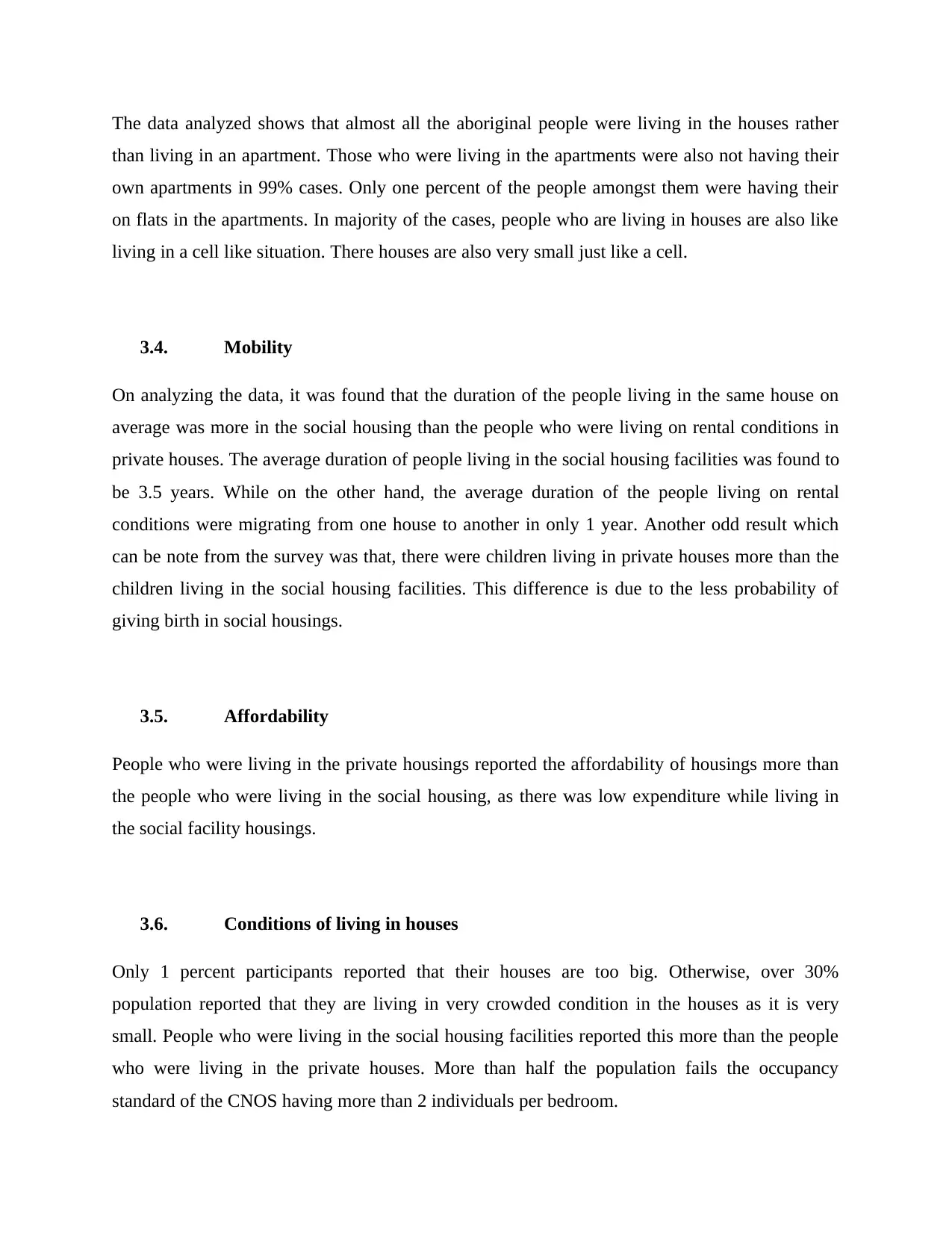
The data analyzed shows that almost all the aboriginal people were living in the houses rather
than living in an apartment. Those who were living in the apartments were also not having their
own apartments in 99% cases. Only one percent of the people amongst them were having their
on flats in the apartments. In majority of the cases, people who are living in houses are also like
living in a cell like situation. There houses are also very small just like a cell.
3.4. Mobility
On analyzing the data, it was found that the duration of the people living in the same house on
average was more in the social housing than the people who were living on rental conditions in
private houses. The average duration of people living in the social housing facilities was found to
be 3.5 years. While on the other hand, the average duration of the people living on rental
conditions were migrating from one house to another in only 1 year. Another odd result which
can be note from the survey was that, there were children living in private houses more than the
children living in the social housing facilities. This difference is due to the less probability of
giving birth in social housings.
3.5. Affordability
People who were living in the private housings reported the affordability of housings more than
the people who were living in the social housing, as there was low expenditure while living in
the social facility housings.
3.6. Conditions of living in houses
Only 1 percent participants reported that their houses are too big. Otherwise, over 30%
population reported that they are living in very crowded condition in the houses as it is very
small. People who were living in the social housing facilities reported this more than the people
who were living in the private houses. More than half the population fails the occupancy
standard of the CNOS having more than 2 individuals per bedroom.
than living in an apartment. Those who were living in the apartments were also not having their
own apartments in 99% cases. Only one percent of the people amongst them were having their
on flats in the apartments. In majority of the cases, people who are living in houses are also like
living in a cell like situation. There houses are also very small just like a cell.
3.4. Mobility
On analyzing the data, it was found that the duration of the people living in the same house on
average was more in the social housing than the people who were living on rental conditions in
private houses. The average duration of people living in the social housing facilities was found to
be 3.5 years. While on the other hand, the average duration of the people living on rental
conditions were migrating from one house to another in only 1 year. Another odd result which
can be note from the survey was that, there were children living in private houses more than the
children living in the social housing facilities. This difference is due to the less probability of
giving birth in social housings.
3.5. Affordability
People who were living in the private housings reported the affordability of housings more than
the people who were living in the social housing, as there was low expenditure while living in
the social facility housings.
3.6. Conditions of living in houses
Only 1 percent participants reported that their houses are too big. Otherwise, over 30%
population reported that they are living in very crowded condition in the houses as it is very
small. People who were living in the social housing facilities reported this more than the people
who were living in the private houses. More than half the population fails the occupancy
standard of the CNOS having more than 2 individuals per bedroom.
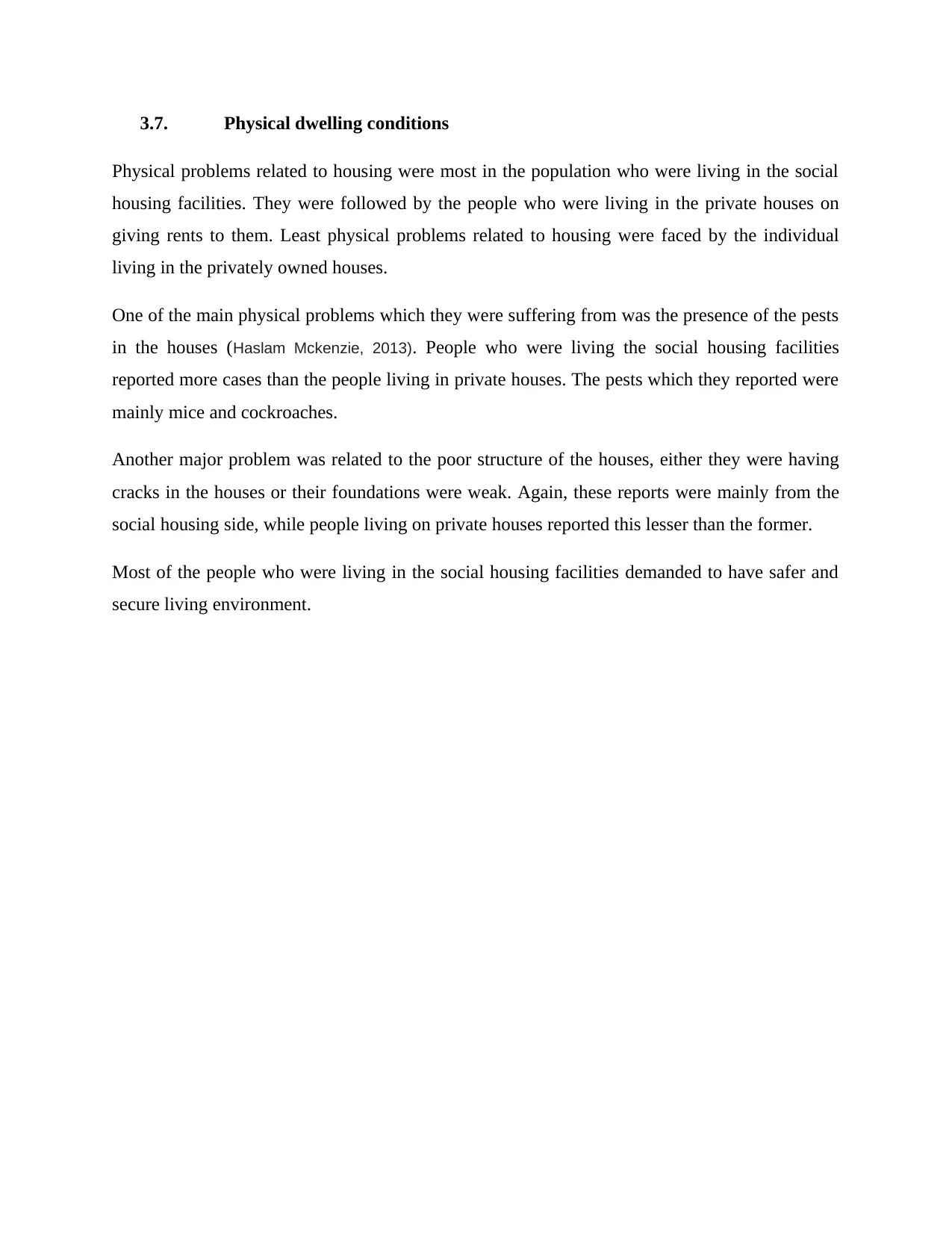
3.7. Physical dwelling conditions
Physical problems related to housing were most in the population who were living in the social
housing facilities. They were followed by the people who were living in the private houses on
giving rents to them. Least physical problems related to housing were faced by the individual
living in the privately owned houses.
One of the main physical problems which they were suffering from was the presence of the pests
in the houses (Haslam Mckenzie, 2013). People who were living the social housing facilities
reported more cases than the people living in private houses. The pests which they reported were
mainly mice and cockroaches.
Another major problem was related to the poor structure of the houses, either they were having
cracks in the houses or their foundations were weak. Again, these reports were mainly from the
social housing side, while people living on private houses reported this lesser than the former.
Most of the people who were living in the social housing facilities demanded to have safer and
secure living environment.
Physical problems related to housing were most in the population who were living in the social
housing facilities. They were followed by the people who were living in the private houses on
giving rents to them. Least physical problems related to housing were faced by the individual
living in the privately owned houses.
One of the main physical problems which they were suffering from was the presence of the pests
in the houses (Haslam Mckenzie, 2013). People who were living the social housing facilities
reported more cases than the people living in private houses. The pests which they reported were
mainly mice and cockroaches.
Another major problem was related to the poor structure of the houses, either they were having
cracks in the houses or their foundations were weak. Again, these reports were mainly from the
social housing side, while people living on private houses reported this lesser than the former.
Most of the people who were living in the social housing facilities demanded to have safer and
secure living environment.
⊘ This is a preview!⊘
Do you want full access?
Subscribe today to unlock all pages.

Trusted by 1+ million students worldwide
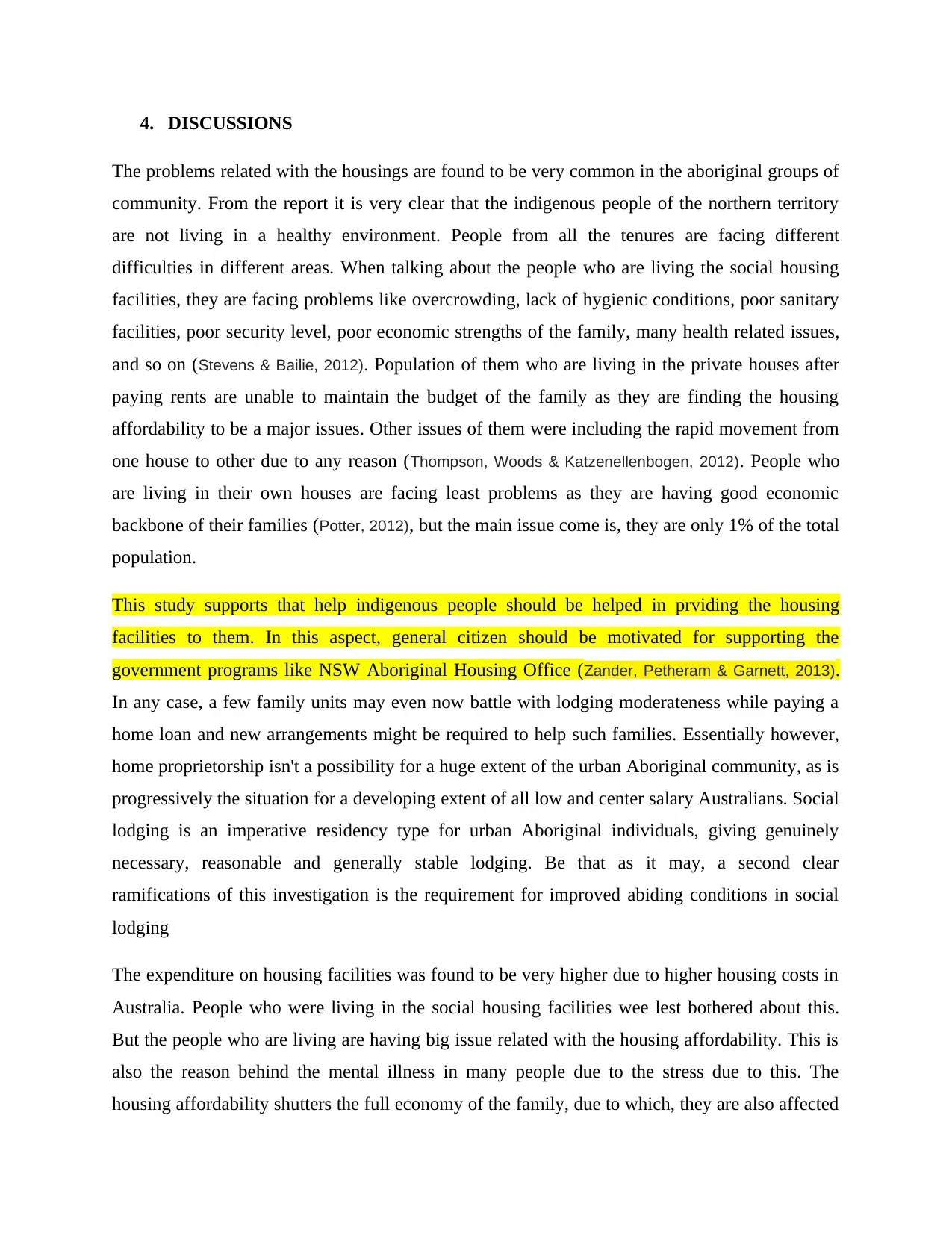
4. DISCUSSIONS
The problems related with the housings are found to be very common in the aboriginal groups of
community. From the report it is very clear that the indigenous people of the northern territory
are not living in a healthy environment. People from all the tenures are facing different
difficulties in different areas. When talking about the people who are living the social housing
facilities, they are facing problems like overcrowding, lack of hygienic conditions, poor sanitary
facilities, poor security level, poor economic strengths of the family, many health related issues,
and so on (Stevens & Bailie, 2012). Population of them who are living in the private houses after
paying rents are unable to maintain the budget of the family as they are finding the housing
affordability to be a major issues. Other issues of them were including the rapid movement from
one house to other due to any reason (Thompson, Woods & Katzenellenbogen, 2012). People who
are living in their own houses are facing least problems as they are having good economic
backbone of their families (Potter, 2012), but the main issue come is, they are only 1% of the total
population.
This study supports that help indigenous people should be helped in prviding the housing
facilities to them. In this aspect, general citizen should be motivated for supporting the
government programs like NSW Aboriginal Housing Office (Zander, Petheram & Garnett, 2013).
In any case, a few family units may even now battle with lodging moderateness while paying a
home loan and new arrangements might be required to help such families. Essentially however,
home proprietorship isn't a possibility for a huge extent of the urban Aboriginal community, as is
progressively the situation for a developing extent of all low and center salary Australians. Social
lodging is an imperative residency type for urban Aboriginal individuals, giving genuinely
necessary, reasonable and generally stable lodging. Be that as it may, a second clear
ramifications of this investigation is the requirement for improved abiding conditions in social
lodging
The expenditure on housing facilities was found to be very higher due to higher housing costs in
Australia. People who were living in the social housing facilities wee lest bothered about this.
But the people who are living are having big issue related with the housing affordability. This is
also the reason behind the mental illness in many people due to the stress due to this. The
housing affordability shutters the full economy of the family, due to which, they are also affected
The problems related with the housings are found to be very common in the aboriginal groups of
community. From the report it is very clear that the indigenous people of the northern territory
are not living in a healthy environment. People from all the tenures are facing different
difficulties in different areas. When talking about the people who are living the social housing
facilities, they are facing problems like overcrowding, lack of hygienic conditions, poor sanitary
facilities, poor security level, poor economic strengths of the family, many health related issues,
and so on (Stevens & Bailie, 2012). Population of them who are living in the private houses after
paying rents are unable to maintain the budget of the family as they are finding the housing
affordability to be a major issues. Other issues of them were including the rapid movement from
one house to other due to any reason (Thompson, Woods & Katzenellenbogen, 2012). People who
are living in their own houses are facing least problems as they are having good economic
backbone of their families (Potter, 2012), but the main issue come is, they are only 1% of the total
population.
This study supports that help indigenous people should be helped in prviding the housing
facilities to them. In this aspect, general citizen should be motivated for supporting the
government programs like NSW Aboriginal Housing Office (Zander, Petheram & Garnett, 2013).
In any case, a few family units may even now battle with lodging moderateness while paying a
home loan and new arrangements might be required to help such families. Essentially however,
home proprietorship isn't a possibility for a huge extent of the urban Aboriginal community, as is
progressively the situation for a developing extent of all low and center salary Australians. Social
lodging is an imperative residency type for urban Aboriginal individuals, giving genuinely
necessary, reasonable and generally stable lodging. Be that as it may, a second clear
ramifications of this investigation is the requirement for improved abiding conditions in social
lodging
The expenditure on housing facilities was found to be very higher due to higher housing costs in
Australia. People who were living in the social housing facilities wee lest bothered about this.
But the people who are living are having big issue related with the housing affordability. This is
also the reason behind the mental illness in many people due to the stress due to this. The
housing affordability shutters the full economy of the family, due to which, they are also affected
Paraphrase This Document
Need a fresh take? Get an instant paraphrase of this document with our AI Paraphraser
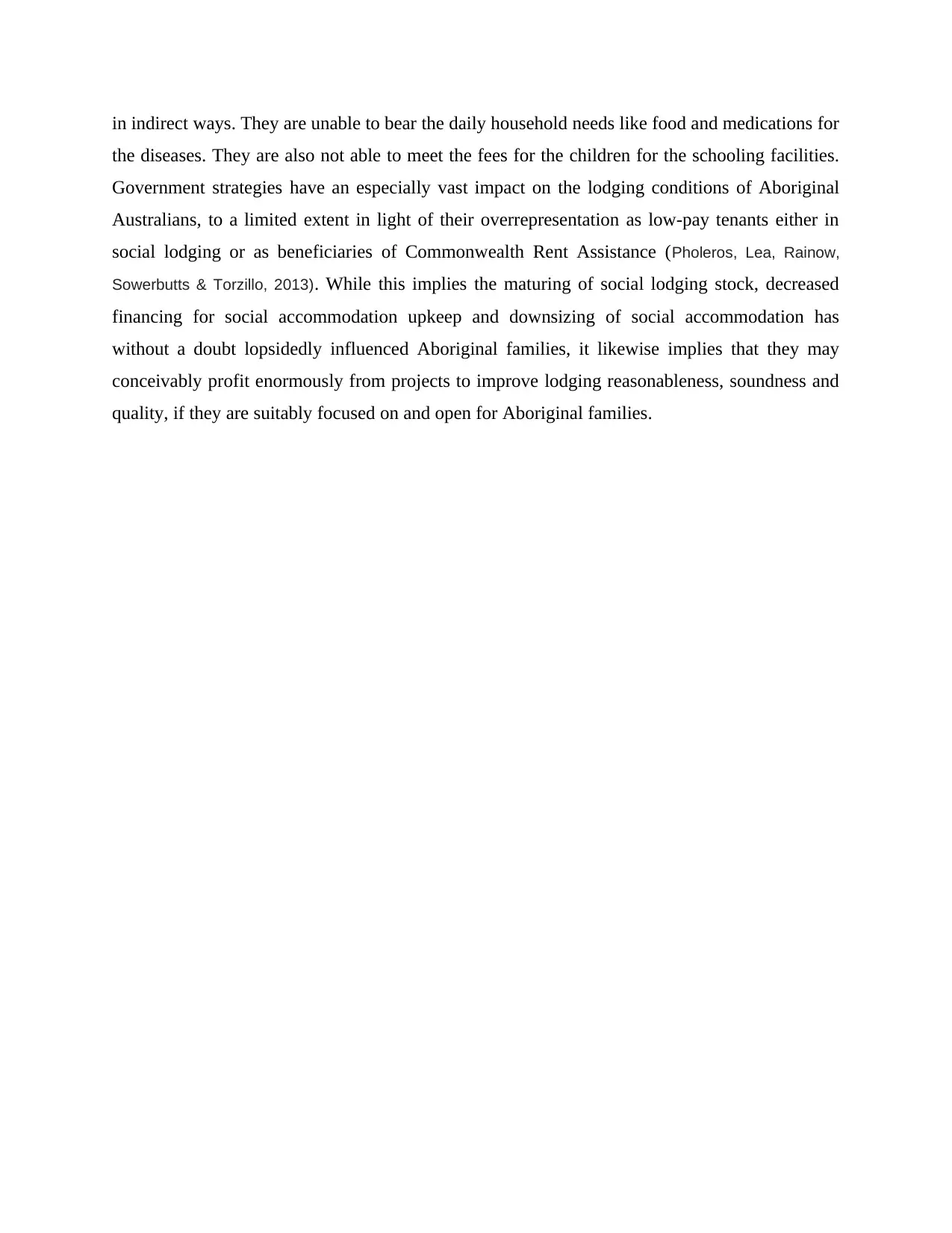
in indirect ways. They are unable to bear the daily household needs like food and medications for
the diseases. They are also not able to meet the fees for the children for the schooling facilities.
Government strategies have an especially vast impact on the lodging conditions of Aboriginal
Australians, to a limited extent in light of their overrepresentation as low-pay tenants either in
social lodging or as beneficiaries of Commonwealth Rent Assistance (Pholeros, Lea, Rainow,
Sowerbutts & Torzillo, 2013). While this implies the maturing of social lodging stock, decreased
financing for social accommodation upkeep and downsizing of social accommodation has
without a doubt lopsidedly influenced Aboriginal families, it likewise implies that they may
conceivably profit enormously from projects to improve lodging reasonableness, soundness and
quality, if they are suitably focused on and open for Aboriginal families.
the diseases. They are also not able to meet the fees for the children for the schooling facilities.
Government strategies have an especially vast impact on the lodging conditions of Aboriginal
Australians, to a limited extent in light of their overrepresentation as low-pay tenants either in
social lodging or as beneficiaries of Commonwealth Rent Assistance (Pholeros, Lea, Rainow,
Sowerbutts & Torzillo, 2013). While this implies the maturing of social lodging stock, decreased
financing for social accommodation upkeep and downsizing of social accommodation has
without a doubt lopsidedly influenced Aboriginal families, it likewise implies that they may
conceivably profit enormously from projects to improve lodging reasonableness, soundness and
quality, if they are suitably focused on and open for Aboriginal families.

5. CONCLUSION OF THE REPORT
After analyzing the report, it can be concluded that:
1. The housing conditions of the indigenous community in the Northern territory are very
poor.
2. Most of them are unable to afford the good housing facilities.
3. Due to poor housings, these people are facing many other problems like physical and
mental illness, illiteracy and increased criminals.
4. Government of the Northern Territory should work for the housing of the indigenous
people living the Northern Territory of Australia.
5. The high predominance of lodging issues in this vast urban Aboriginal accomplice
propose the requirement for general wellbeing, lodging and different experts to unite with
Aboriginal individuals and associations in upholding for improved access to good and
reasonable housing. The noteworthy disparities in the housing issues detailed by family
units in various residency types recommend the potential requirement for separated
strategy reactions.
After analyzing the report, it can be concluded that:
1. The housing conditions of the indigenous community in the Northern territory are very
poor.
2. Most of them are unable to afford the good housing facilities.
3. Due to poor housings, these people are facing many other problems like physical and
mental illness, illiteracy and increased criminals.
4. Government of the Northern Territory should work for the housing of the indigenous
people living the Northern Territory of Australia.
5. The high predominance of lodging issues in this vast urban Aboriginal accomplice
propose the requirement for general wellbeing, lodging and different experts to unite with
Aboriginal individuals and associations in upholding for improved access to good and
reasonable housing. The noteworthy disparities in the housing issues detailed by family
units in various residency types recommend the potential requirement for separated
strategy reactions.
⊘ This is a preview!⊘
Do you want full access?
Subscribe today to unlock all pages.

Trusted by 1+ million students worldwide
1 out of 14
Related Documents
Your All-in-One AI-Powered Toolkit for Academic Success.
+13062052269
info@desklib.com
Available 24*7 on WhatsApp / Email
![[object Object]](/_next/static/media/star-bottom.7253800d.svg)
Unlock your academic potential
Copyright © 2020–2025 A2Z Services. All Rights Reserved. Developed and managed by ZUCOL.





